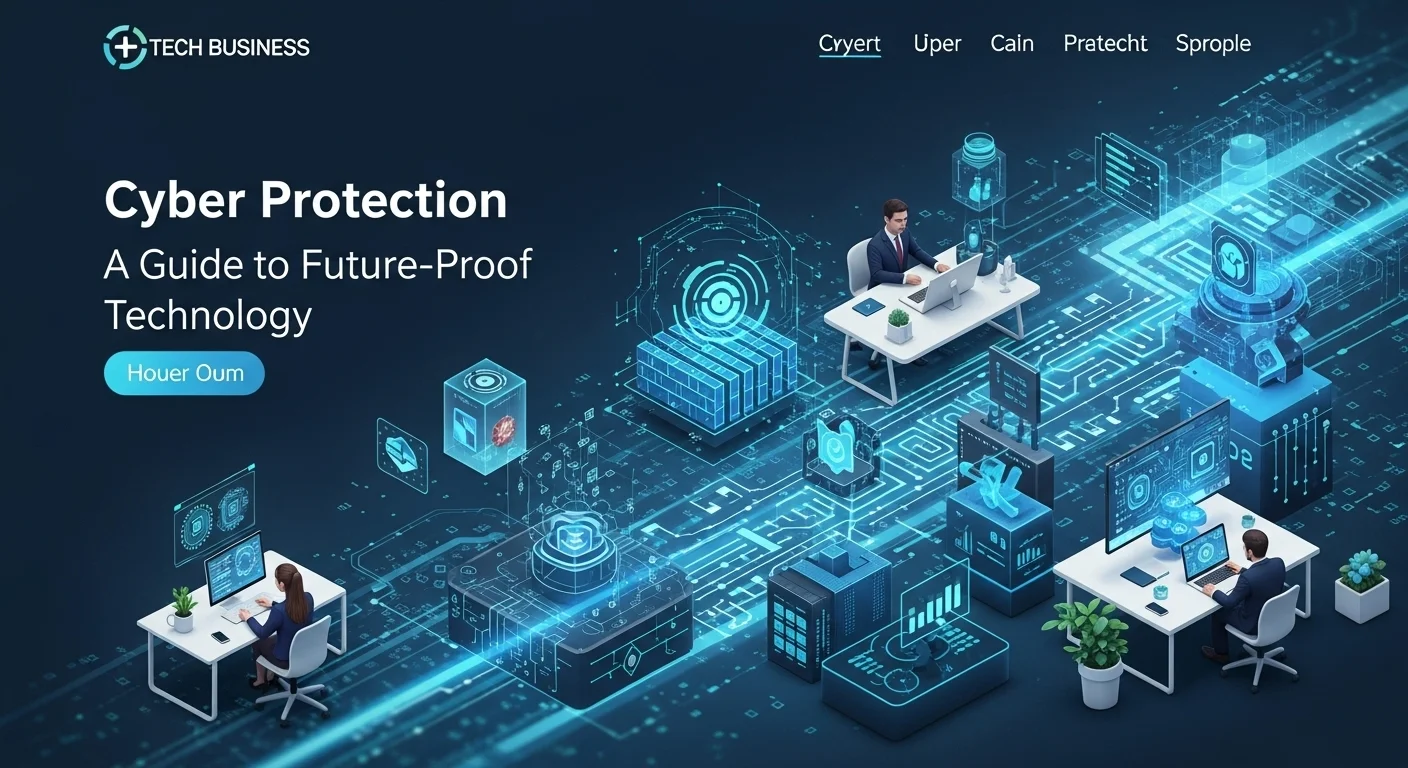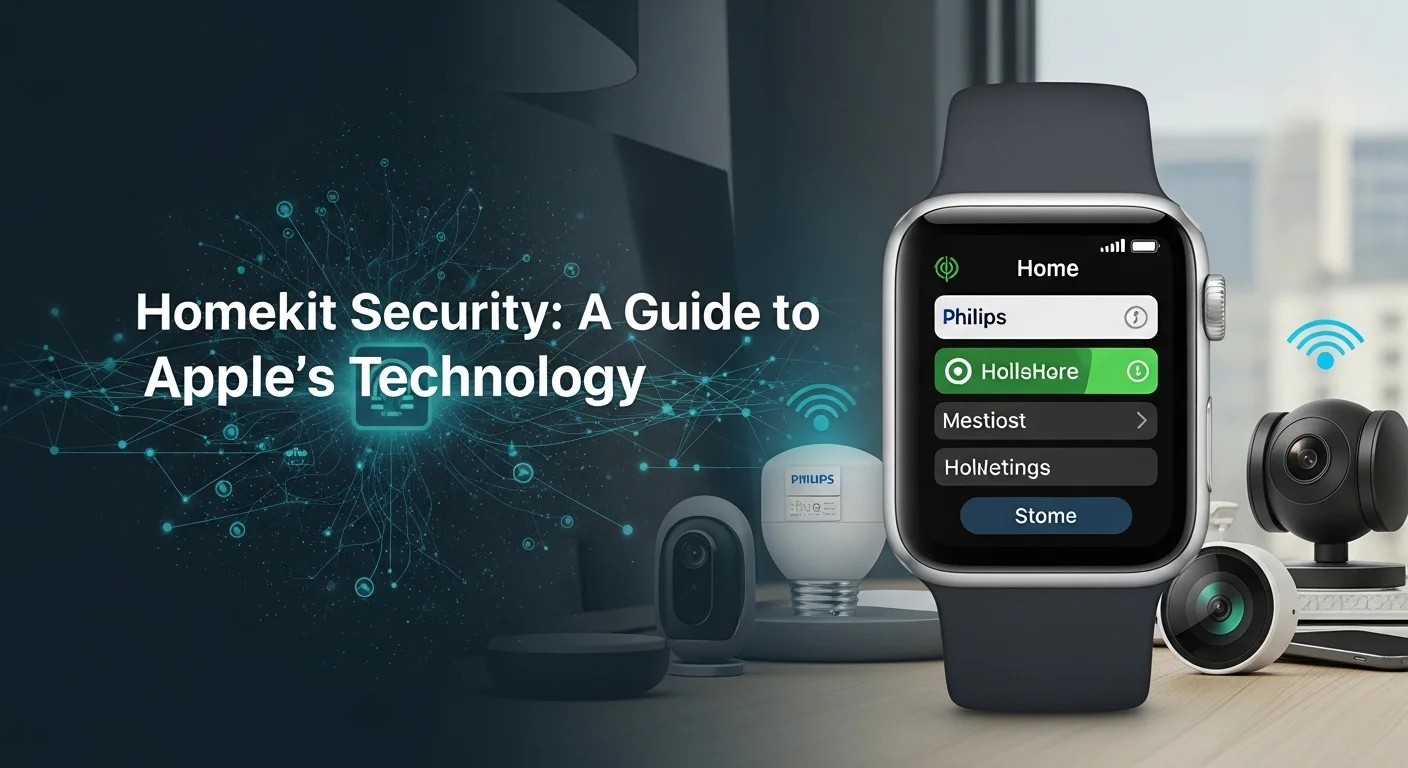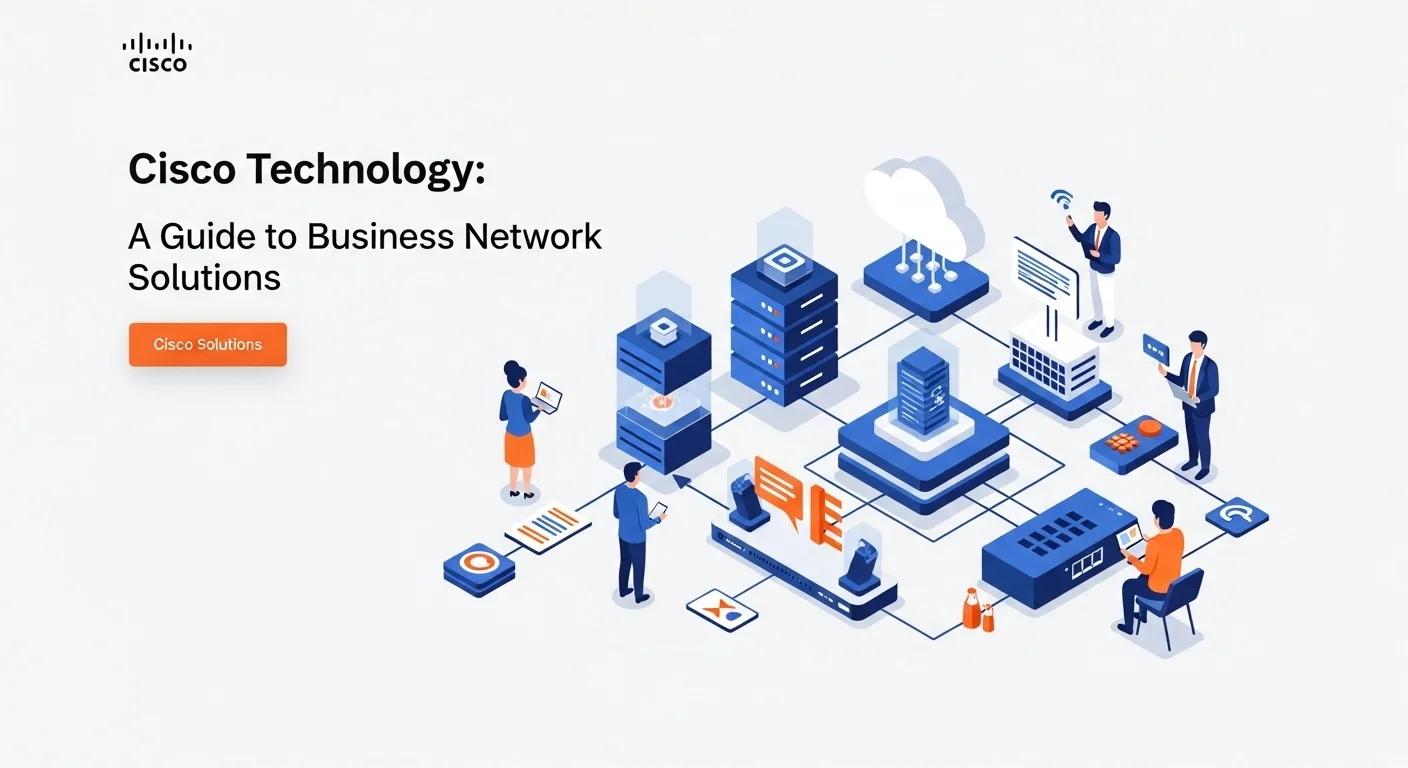Beyond Antivirus: A Real-World Guide to Cyber Protection

Executive Summary
In my years working in digital security, I've seen countless businesses focus on building walls, thinking a strong firewall is all they need. But in today's world, that's like locking your front door but leaving the windows wide open. This guide is about moving beyond that outdated mindset. We’re diving into Cyber Protection, a holistic strategy that's about more than just preventing attacks—it's about ensuring your business can survive and thrive no matter what happens. We'll explore the critical difference between basic cybersecurity and true cyber protection, which wraps data safety, backup, and recovery into one powerful shield. For anyone running a business or just trying to stay safe online, this means learning to protect the data itself, keeping it safe, available, and confidential. We'll walk through creating a complete strategy, from smart threat detection to training your team, so you can build a resilient operation and earn the unwavering trust of your customers. Think of this as your personal roadmap to mastering data safety in the modern digital age.
Table of Contents
What is Cyber Protection and why is it important in Technology?
In the tech world, 'cybersecurity' is a term we hear every day. But I've found that a more powerful and essential concept is taking its place as the bedrock of digital survival: Cyber Protection. People often use these terms as if they mean the same thing, but there's a world of difference. Cyber Protection is an evolution, a smarter strategy that combines data protection with cybersecurity to create a shield that can stand up to almost anything. This isn't just about changing words; it's about a fundamental shift in how we think about our digital lives, where our data is our most precious asset, and protecting it is everything.
Think of it this way: traditional cybersecurity is about building a fortress. It’s your firewalls, antivirus software, and alarm systems—all designed to keep bad guys out. Cyber Protection, on the other hand, starts with the hard truth that sooner or later, someone might get past your defenses. So, it expands the mission to not only prevent attacks but also to ensure the safety, accessibility, and integrity of your data, even if a breach happens. This is where cyber security and data protection truly merge. I've seen companies with top-of-the-line firewalls get crippled because an employee accidentally deleted a critical file and there was no backup plan. Cyber protection solves this by weaving backup, disaster recovery, and data management right into the security plan. It means that whether you're hit by a ransomware attack, a server failure, or human error, your data remains safe and you can get back on your feet quickly.
In today's tech landscape, you can't overstate how vital this integrated approach is. We're surrounded by data. With the Internet of Things (IoT), cloud computing, and AI, businesses rely on more information than ever before. This data is the engine of a modern company, driving customer relationships, product innovation, and strategic decisions. If that data is lost or stolen, the results can be catastrophic—we're talking huge financial losses, a damaged reputation, and serious legal trouble for not complying with rules like GDPR. That's why a modern defense strategy must be built around cyber data protection, treating data as the crown jewels that need to be secured above all else.
The Business Imperative for Holistic Cyber Protection
For any business today, embracing cyber protection isn’t just a good idea; it's a strategic necessity. The threats we face are evolving at a dizzying pace. Cybercriminals are smarter, more organized, and have more resources than ever. They use sophisticated tactics, from AI-driven malware that learns how to bypass defenses to clever scams that trick your employees. Trusting only in preventative cybersecurity is like building a castle with only one wall; a determined attacker will eventually find a way in. This is where the real value of comprehensive cyber protection services shines through. They offer layers of defense that prepare you for when things go wrong.
Let me paint a picture I’ve seen play out too many times: a ransomware attack. A traditional security setup might not stop the initial breach. Suddenly, all your critical files are encrypted, and your business grinds to a halt. The attackers demand a huge ransom, and you're stuck with a horrible choice: pay them (with no guarantee you'll get your data back) or suffer through weeks of downtime and data loss. A cyber protection strategy completely changes this scenario. While the breach is still a major problem, the built-in data protection means you have secure, recent, and easily accessible backups of everything. Instead of dealing with criminals, you can focus on cleaning up the mess, restoring your data from the backup, and getting back to business, often in a matter of hours, not weeks. This ability to bounce back is what effective data protection cyber security is all about.
On top of that, being proactive about cyber protection helps with regulations and builds trust with your customers. Almost every industry has strict rules about how customer data is handled. A breach that exposes sensitive information can lead to massive fines. By putting a solid cyber protection plan in place—with encryption, access controls, and regular checks—you can show you're serious about protecting data. And that commitment becomes a huge advantage. In a world full of data breach headlines, customers are getting smarter about who they trust with their information. A business that can confidently talk about its strong cyber security and data protection measures will earn a reputation for being reliable and secure, winning over customers who care about their privacy.
Choosing the Right Defense: The Role of Cyber Attack Protection Companies
Figuring out this complex world of digital defense can feel overwhelming, especially for small and medium-sized businesses that don't have a dedicated security team. This is where specialized cyber attack protection companies become so important. These firms bring the expertise, technology, and people needed to build and manage a complete cyber protection strategy. When you’re looking for a partner, you need to think beyond basic antivirus and firewall management. A real cyber protection provider offers a fully integrated suite of services.
Here's what I recommend looking for:
- Managed Detection and Response (MDR): A 24/7 watchtower for your network and devices, ready to spot threats in real-time and act immediately to shut them down.
- Advanced Endpoint Protection: This is more than just antivirus. It uses AI and behavioral analysis to stop even the most sophisticated malware, including attacks that don't use traditional files.
- Secure Backup and Disaster Recovery (BDR): Think of this as your ultimate insurance policy. It's automated, encrypted backups of all your critical data and systems, with the ability to recover quickly and keep your business running.
- Vulnerability Management: A proactive service that scans your systems for weaknesses and helps you patch them before attackers can find them.
- Security Awareness Training: Your people can be your strongest defense. This involves training them to spot and avoid phishing, scams, and other tricks.
- Compliance Management: Expert help to make sure you're following all the data protection rules and regulations in your industry.
Leading firms like CrowdStrike, Palo Alto Networks, and Fortinet offer many of these advanced platforms that bring security and data management together. For many businesses, the best move is to team up with a Managed Service Provider (MSP) that specializes in cyber protection. They can package the best tools and provide the day-to-day management you need to stay safe. They become your outsourced security team, letting you focus on your business while they ensure your digital world is defended by a resilient and holistic cyber data protection strategy. This fusion of prevention, detection, response, and recovery is the core of modern cyber protection, giving you the strength to succeed in today's complex digital world.

Your Complete Guide to Cyber Protection in Technology and Business
Building a truly resilient digital operation isn't about buying a single piece of software. It’s a discipline that weaves together smart technology, strategic business planning, and a security-first mindset. I've worked with companies to create this from the ground up, and it's about making security a natural part of how you operate. This guide will walk you through the essential components—from the technical tools to the company-wide strategies—giving you a clear roadmap to digital resilience. The goal is to make data protection cyber security a core value, not just a line item on a budget.
Your Digital Fortress: The Technical Toolkit
A strong cyber protection strategy is built on layers of smart technology. We call this 'defense-in-depth,' and the idea is simple: if one defense fails, another is there to catch the threat. It’s about creating multiple barriers between an attacker and your valuable data.
1. Network Security: Your First Line of Defense
- Next-Generation Firewalls (NGFWs): These aren't your old-school firewalls. They do more than just check traffic; they understand applications, have built-in threat prevention, and are constantly updated with new intelligence to block emerging threats.
- Network Segmentation: A tactic I always recommend. It involves breaking your network into smaller, isolated zones. If an attacker gets into one area, segmentation stops them from spreading to the entire network. It's like having watertight compartments on a ship.
- Secure Wi-Fi and VPNs: Always use the strongest encryption available (like WPA3) for your Wi-Fi. And for anyone working remotely, a Virtual Private Network (VPN) is non-negotiable. It creates a secure, encrypted tunnel for all their traffic.
2. Endpoint Protection: Securing Every Device
- Endpoint Detection and Response (EDR): Every laptop, server, and phone is an 'endpoint.' EDR tools are like security guards on each device, constantly watching for suspicious activity. If they spot trouble, they can automatically isolate the device to stop an attack from spreading.
- Next-Generation Antivirus (NGAV): This is antivirus on steroids. Using AI and machine learning, NGAV can spot and block brand-new malware that has never been seen before, including tricky 'fileless' attacks.
3. Data Encryption: Protecting the Crown Jewels
- Encryption at Rest and in Transit: This is where cyber data protection gets personal. Your data must be scrambled (encrypted) both when it's being stored on a hard drive and when it's moving across the internet. This way, even if someone steals the data, it’s just unreadable gibberish to them.
- Data Loss Prevention (DLP): These are smart tools and policies that act as a gatekeeper for your sensitive information. They can scan emails and files to stop confidential data, like customer lists or financial records, from leaving your network without permission.
4. Identity and Access Management (IAM): Controlling Who Gets In
- Multi-Factor Authentication (MFA): From my experience, this is one of the single most effective security measures you can implement. Requiring a second proof of identity (like a code from your phone) makes stolen passwords almost useless to an attacker.
- Principle of Least Privilege (PoLP): A simple but powerful rule: people should only have access to the data and systems they absolutely need to do their jobs. This minimizes the damage if one of their accounts is ever compromised.
- Zero Trust Architecture: This is the future of security. It's built on the motto 'never trust, always verify.' It means every single request for access is challenged and verified, even if it's coming from inside your own network.
5. Secure Backup and Recovery: Your Ultimate Safety Net
- The 3-2-1 Rule: This is the gold standard for backups. Keep at least three copies of your data, on two different types of storage, with one of those copies stored off-site and disconnected. This off-site copy is your ultimate defense against disasters like fire or ransomware.
- Regular Testing: A backup you haven't tested is just a prayer. I always tell my clients to regularly test their recovery process to make sure it actually works. You don't want to find out your backups are corrupted in the middle of a real crisis.
Beyond the Tech: Building a Security-First Culture
All the technology in the world won't save you if your company culture doesn't prioritize security. True cyber protection requires a strategic commitment from everyone, from the CEO down. This is how you forge a real bond between cyber security and data protection through your policies and your people.
1. Develop a Comprehensive Cyber Protection Plan: This is your master strategy. It starts with a risk assessment to figure out what's most valuable and what the biggest threats are. The plan should clearly define who is responsible for what and lay out the exact steps for handling security incidents.
2. Create an Incident Response (IR) Plan: When a breach happens, panic is your enemy. A clear, pre-written plan is your best friend. It should detail every step, from detecting the problem and containing it to getting rid of the threat and recovering. It should also include a plan for communicating with customers and authorities, ensuring a calm and coordinated response.
3. Invest in Your People: Your employees are often targeted, but with the right training, they can become your best defenders. Regular, engaging training on threats like phishing is essential. I'm a big fan of running fake phishing tests—they're a great way to teach people what to look for. Create a culture where people feel comfortable reporting anything suspicious, without fear of being blamed.
4. Manage Your Supply Chain Risk: Your security is linked to your partners'. Many huge breaches started with an attack on a smaller third-party vendor. You have to vet the security of any partner who has access to your network or data. This means clear security requirements in your contracts and regular checks.
5. Choose the Right Partners: For most businesses, working with expert cyber attack protection companies or Managed Security Service Providers (MSSPs) is the smartest move. When you're looking for cyber protection services, find a provider that offers a complete solution. They shouldn't just sell you software; they should provide the strategic advice and expertise to weave it into your business, creating a truly comprehensive approach to cyber data protection.
By blending these technical defenses with smart business strategies, you can build a powerful shield. This complete approach to data protection cyber security doesn't just stop attacks; it builds resilience, ensuring your business can weather any storm and operate with confidence in a dangerous digital world.

Practical Tips and Strategies to Master Cyber Protection
In my experience, achieving great cyber protection isn't about a single grand gesture; it's about the small, consistent actions you take every day, combined with smart, forward-thinking strategies. It's an ongoing journey of staying alert, adapting to new threats, and constantly improving. This section is all about actionable advice—simple habits and advanced strategies—to strengthen your defenses. By focusing on these steps, you can shift from a reactive, fearful posture to a proactive state of resilience, making cyber data protection a natural and powerful part of your life and business.
Foundational Best Practices: The Daily Habits of Digital Safety
Think of these as the digital equivalent of brushing your teeth. They are simple, foundational habits that prevent the vast majority of common cyber threats. Making them a consistent part of your routine is the single most important step you can take.
- Master Your Passwords: Weak and reused passwords are like leaving your keys in the door. Insist on long, complex passwords (I recommend at least 15 characters). Even better, use passphrases (like 'Three-Crazy-Robots-Ran-Fast!') which are much easier to remember. The golden rule: a unique password for every single account. No exceptions.
- Get a Password Manager: Honestly, the best security decision I ever made was using a password manager. It's impossible to remember dozens of unique passwords. A password manager does it for you, securely storing them and creating strong, random ones whenever you need them. It's a game-changer.
- Turn On Multi-Factor Authentication (MFA) Everywhere: MFA is your best defense against stolen passwords. If you do nothing else from this list, do this. Activate it on your email, banking, social media—anywhere it's offered. Even if a thief has your password, they can't get in without that second code from your phone.
- Stay Skeptical of Phishing: Phishing is still one of the biggest threats. Train yourself and your team to be suspicious of unexpected emails, especially those that create panic or ask for personal information. Always check the sender's email address and hover your mouse over links to see where they really go before you click. My motto is: when in doubt, throw it out.
- Keep Everything Updated: Those annoying update notifications are your friends. They often contain critical security fixes for newly found vulnerabilities. Set your operating systems, browsers, and apps to update automatically so you're always protected.
- Lock Down Your Network: Change the default admin password on your home or office router immediately. Use a strong, unique password for your Wi-Fi network and make sure it's using the latest WPA3 encryption standard.
Leveling Up: Advanced Strategies and Tools for Businesses
For businesses, good habits are just the start. To handle more sophisticated threats, you need strategic planning and advanced tools. This is where partnering with skilled cyber attack protection companies can make a huge difference.
1. Adopt a Zero Trust Mindset: This is a powerful strategic shift. Instead of trusting anyone inside your network, a Zero Trust approach assumes no one is safe and verifies every single request for access. It’s the core of modern data protection cyber security because it severely limits an attacker's ability to move around your network if they do get in.
2. Harness the Power of AI and Machine Learning: The future of security is smart and automated. Modern tools use AI to spot threats that a human could never find. These intelligent systems analyze patterns in network traffic and user behavior to identify and even predict attacks in real-time. When you're looking at cyber protection services, make sure they have a strong AI component.
3. Conduct Regular Health Checks: Risk Assessments and Pen Testing: You can't protect what you don't understand. A regular risk assessment helps you identify your most important assets and your biggest vulnerabilities. For a real-world stress test, I highly recommend periodic penetration testing ('pen testing'), where you hire ethical hackers to try and break into your systems. It’s the best way to find your weak spots before the bad guys do.
4. Build an Unbreakable Backup and Recovery Plan: Effective cyber security and data protection is about being prepared for the worst-case scenario. Your backup strategy should follow the 3-2-1 rule: three copies of your data, on two different types of media, with one copy kept off-site. For bulletproof protection against ransomware, that off-site copy should be 'immutable,' meaning it can't be changed or deleted by an attacker on your main network.
5. Invest in Your Human Firewall: Your employees are a critical part of your defense. Go beyond a boring annual slideshow. Create a continuous security awareness program with engaging content like short videos and phishing simulations. When you build a culture where people feel safe reporting mistakes and asking questions, you turn your biggest potential weakness into your strongest asset.
6. Choose Your Tech Partners Wisely: The security market is noisy. Stick with reputable vendors and service providers. When vetting cyber attack protection companies, look for proven results, great customer feedback, and a holistic vision that combines multiple layers of security. For excellent, government-backed advice, I often point people to the Cybersecurity & Infrastructure Security Agency (CISA) website at cisa.gov. It’s a fantastic resource for businesses of all sizes.
By blending these foundational habits with forward-thinking strategies, you'll dramatically improve your security posture. True cyber data protection is about creating a layered defense that empowers your people, protects your assets, and prepares you to face the future with confidence.
Expert Reviews & Testimonials
Sarah Johnson, Business Owner ⭐⭐⭐
This was a good overview of Cyber Protection, but as a small business owner, I would have loved to see a few more real-world examples I could apply directly.
Mike Chen, IT Consultant ⭐⭐⭐⭐
A solid article on Cyber Protection. It clarified the key differences for me, though a couple of the more technical concepts could have been simplified a little more.
Emma Davis, Tech Expert ⭐⭐⭐⭐⭐
Absolutely fantastic article! A truly comprehensive guide to Cyber Protection. It's been incredibly helpful for my work, and I found it perfectly clear and easy to follow.



